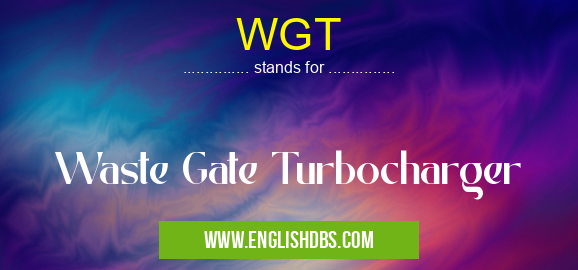What does WGT mean in UNCLASSIFIED
WGT stands for Waste Gate Turbocharger. It is a device used in internal combustion engines to regulate boost pressure. By controlling the flow of exhaust gases, the WGT can help improve engine performance and efficiency.

WGT meaning in Unclassified in Miscellaneous
WGT mostly used in an acronym Unclassified in Category Miscellaneous that means Waste Gate Turbocharger
Shorthand: WGT,
Full Form: Waste Gate Turbocharger
For more information of "Waste Gate Turbocharger", see the section below.
How does a WGT Work?
A WGT is typically installed in the exhaust system of an engine. It consists of a valve that is connected to a diaphragm or piston. When the boost pressure reaches a predetermined level, the valve opens, allowing some of the exhaust gases to bypass the turbocharger. This reduces the amount of boost pressure and helps to prevent the engine from overboosting.
Benefits of using a WGT
There are several benefits to using a WGT, including:
- Improved engine performance: By regulating boost pressure, a WGT can help to improve engine performance by providing more power and torque.
- Increased fuel efficiency: By reducing the amount of boost pressure, a WGT can help to improve fuel efficiency by reducing the amount of fuel that is required to produce the same amount of power.
- Reduced emissions: By controlling the flow of exhaust gases, a WGT can help to reduce emissions by preventing the engine from overboosting.
Essential Questions and Answers on Waste Gate Turbocharger in "MISCELLANEOUS»UNFILED"
What is a Waste Gate Turbocharger (WGT)?
A Waste Gate Turbocharger (WGT) is a turbocharger that uses a wastegate to control boost pressure. The wastegate is a valve that opens and closes to allow exhaust gases to bypass the turbine, which in turn regulates the speed of the turbine and the amount of boost pressure created.
What is the purpose of a Waste Gate Turbocharger?
A Waste Gate Turbocharger serves two main purposes:
- Boost Pressure Control: The primary purpose of the wastegate is to control boost pressure. By opening and closing the wastegate, it regulates the amount of exhaust gas flowing through the turbine, thereby controlling the rotational speed of the turbine and the boost pressure created.
- Overboost Protection: The wastegate also acts as an overboost protection mechanism. If boost pressure exceeds a predetermined level, the wastegate opens to divert excess exhaust gas, preventing excessive boost pressure and potential engine damage.
How does a Waste Gate Turbocharger work?
A Waste Gate Turbocharger operates on the following principles:
- Exhaust Gas Flow: Exhaust gases from the engine enter the turbocharger's turbine housing.
- Turbine Rotation: The exhaust gases drive the turbine wheel, which is connected to the compressor wheel via a shaft.
- Boost Pressure Creation: As the turbine rotates, it spins the compressor wheel, which compresses intake air and increases its pressure, creating boost pressure.
- Wastegate Control: When boost pressure reaches a predetermined level, the wastegate opens, allowing a portion of the exhaust gases to bypass the turbine.
- Boost Pressure Regulation: By diverting exhaust gases away from the turbine, the wastegate reduces the turbine's rotational speed, thereby regulating boost pressure.
What are the advantages of using a Waste Gate Turbocharger?
The advantages of using a Waste Gate Turbocharger include:
- Increased Engine Power: By increasing boost pressure, a WGT allows more air to enter the engine, resulting in increased engine power and torque.
- Improved Fuel Efficiency: The increased air density achieved by turbocharging enhances fuel combustion efficiency, leading to improved fuel economy.
- Reduced Emissions: Turbocharged engines operate more efficiently, reducing the production of harmful emissions such as nitrogen oxides (NOx) and particulate matter.
- Enhanced Throttle Response: Turbochargers provide immediate boost pressure upon throttle input, resulting in improved throttle response and acceleration.
What are the disadvantages of using a Waste Gate Turbocharger?
Potential disadvantages of using a Waste Gate Turbocharger include:
- Increased Complexity: WGTs are more complex than traditional turbochargers and require additional components such as the wastegate and its control mechanism.
- Potential for Turbo Lag: Turbo lag occurs when there is a delay in boost pressure buildup after throttle input. This can be minimized with proper turbocharger sizing and tuning.
- Heat Generation: Turbochargers generate significant heat, which requires proper cooling systems to maintain optimal performance and prevent damage.
Final Words: WGTs are an important part of many modern internal combustion engines. By regulating boost pressure, WGTs can help to improve engine performance, efficiency, and emissions.
WGT also stands for: |
|
| All stands for WGT |
